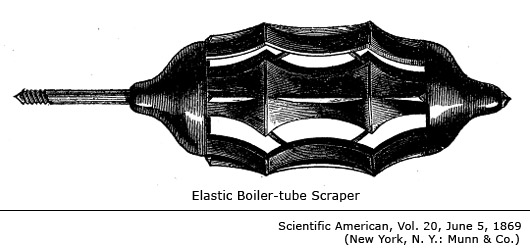As the engineering public is gradually becoming educated to the
realization of the economy of keeping boilers clean, a
considerable number of devices have been patented to meet the
demand for a good tool to clean out flues.
Brushes have been tried, but the deposit which forms in flues
needs something more powerful than them for its effectual
removal.
We last week illustrated an improved boiler flue scraper, and
this week we lay before our readers a description and engraving
of another device for the same purpose, the invention of Mr. E.
L. Pratt, deceased, late of Beverly, Mass., a patent for which
was granted to H. L. Pratt, administrator, May 11, 1869.

This scraper consists of two tapering heads, the broad parts of
each facing the other, fixed upon a pipe or rod at a short
distance from each other. The broad ends of the heads have
mortise-like recesses formed in them, which receive the ends of
the cutters; the mortises being large enough to admit
considerable play of the cutters to and from the longitudinal
axis of the instrument.
Each of the cutters has two cutting edges at right angles with
its longitudinal axis; so arranged that any part of the surface,
omitted by the forward one, shall be scraped by the other. These
are also contracted in the middle into a shape approximating the
section of an hour-glass, so that all the soot falls into the
central part of the instrument between the cutters, and is drawn
out with it.
The cutters are pressed out against the sides of the flues by
elliptical plate springs, which also permit the scraper to enter
and clean flues of various sizes. The cutters are to be made of
chilled iron which will render them very durable.
From the
cutting edges of the cutters extend, toward each head, ribs
which facilitate the entrance of the instrument; and they also
have a central rib extending between the cutting edges, which
facilitates the entering of the hinder cutting edges, while it
is sufficiently depressed not to interfere in the least with
their operation.
The scraper is so cheaply made that it is designed to furnish
them for every diameter of tube, and in such case, the cutting
edges are made to fit the curvature of the interior surface of
the flue. It is claimed that this scraper is cheaper, more
durable, and effective than any form of wire brush.
Orders should be addressed to Miller's Falls Manufacturing Co.,
87 Beekman St., New York city.
Scientific American, Vol. 20, June 5, 1869,
(New York, N. Y.: Munn & Co.)
Related Info
Wiktor A. Kuc
January, 2015
We want to hear from you - write to:
info@wkFineTools.com